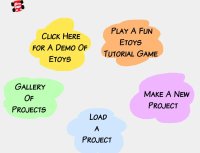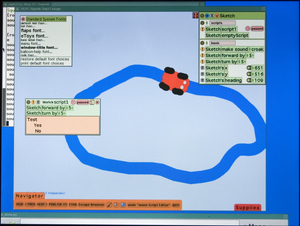Etoys
| Etoys | |
| Status: | in build |
| Version: | 50 |
| Base: | Yes |
| Source: | git:projects/etoys |
| l10n: | launchpad |
| Contributors | |
| Bert Freudenberg, Ted Kaehler, Alan Kay, Yoshiki Ohshima, Ian Piumarta, Kim Rose, Scott Wallace, Takashi Yamamiya, and many others | |
Squeak Etoys was inspired by LOGO, PARC-Smalltalk, Hypercard, and starLOGO. It is a media-rich authoring environment with a simple, powerful scripted object model for many kinds of objects created by end-users that runs on many platforms, and it is free and open source. It includes 2D and 3D graphics, images, text, particles, presentations, web-pages, videos, sound and MIDI, etc. It includes the ability to share desktops with other Etoy users in real-time, so many forms of immersive mentoring and play can be done over the Internet. It is multilingual, runs on more than 20 platforms bit-identically, and has been successfully used in the USA, Europe, South America (Brazil, Colombia, Argentina), Asia (Japan, Korea, India, Nepal), and elsewhere.
Further reading: http://www.squeakland.org/school/HTML/essays/essays.html
Mailing list
There is a mailing list specifically discussing Etoys in the OLPC environment: etoys(at)laptop.org. Please subscribe to keep in touch!
For Teachers and Learners
There is a document describing everything you need to know about eToys on the XO here.
For Etoys designers
To build etoys, the best thing would be to use the actual OLPC image. However, etoys authored using the squeakland.org version should be fairly compatible. Remember that the actual screen of the kids' machines will be very small, even though it has a 1200x900 resolution!
We are planning a contest for the best etoys designed to work on the OLPC machines. The winners will be included in the repository distributed with 5 million machines next year. Precise criteria and the format for submissions are being worked on, but a good entry should be fun, suitable for younger kids (text shouldn't be too complex), hackable (code should be elegant), compact (disk space is precious), and should illustrate some creative aspects of using Etoys. Of course the best examples might be existing etoys rewritten to work nicely on the laptops.
Come back to this page in a few days for more information.
For Etoys Tranalators
gettext files are available at https://translations.launchpad.net/etoys/.
For Developers
The current Etoys version for OLPC is based on the squeakland.org image. It runs on the latest Squeak VM with minimal Sugar glue code.
Images can be downloaded at http://tinlizzie.org/olpc, though "Tin Lizzie" is a different project.
- etoys-dev-2.1-1535.zip contains dev image+changes (use this for developing changesets)
Remember to update your image!
- etoys-image-and-pr.zip is a zip of the very latest image and projects in the git tree
Activity Source: http://dev.laptop.org/git.do?p=projects/etoys
git clone git://dev.laptop.org/projects/etoys
There is a mirror of the latest git tree at http://etoys.laptop.org/src
RPMs: The Squeak VM and Etoys activity are packaged as RPMs. The easiest way to get them is with yum:
wget http://etoys.laptop.org/olpc-etoys.repo cp olpc-etoys.repo /etc/yum.repos.d/ yum install etoys
To stay up-to-date, just do
yum update etoys squeak-vm
See Etoys RPM and XO bundle for the release process.
Sugar: For running inside the Sugar emulator, use sugar-jhbuild:
./sugar-jhbuild buildone squeak ./sugar-jhbuild buildone etoys
Etoys are built by default in the latest sugar-jhbuild.
Bugs: Please submit tickets at http://dev.laptop.org/, select the "Etoys" component.
Build etoys.image from developer's image
- place project files for 'Welcome' 'DemonCastle1' 'Gallery' 'Launcher'.
- set screen size as 1200 @ 900.
- save as 'etoys.image'.
ReleaseBuilderSqueakland new prepareReleaseImageForOLPC.
Running OLPC Etoys if you do not have OLPC laptop yet - For Content Creators/Testers/Teachers
If you, as most of us, do not have the OLPC laptop, you can still develop OLPC Etoys content. There will be a few minor integration points missing (Camera etc), but most content and testing can still be performed. This section describes how to achieve this.
Method 1 (Easiest) - Use Squeakland installation and the OLPC image
The idea behind this method is to install, on your favorite operating system, the Squeakland Etoys system, and download the OLPC Etoys image and content. Then use the Squeakland virtual machine to run the OLPC image.
How to install OLPC Etoys on your system? (Skip Step 1 and 2 below if you already have Squeak installed.)
- On Windows
- Download and install Etoys from Squeakland. Go to the Squeakland link; in the middle of the page, click on the "Download Squeak" button. On the next page, click on the "Download Squeak" link. Click "Open" on the browser dialog asking you to open or save the SqueakPluginInstaller.exe.
- A Squeak Plugin Installer installation dialog will come up; click on "Next", then "Close". This will install Squeak on your system, and create an item on your desktop named Squeak, which looks like this:

- Now Download the OLPC version of Etoys. The latest version can be downloaded from this site. You will need an extract program (such as PKZip, WinZip, or 7Zip) to extract this. Create a folder named "C:\Etoys-OLPC" or similar, and extract the contents of the downloaded etoys-image-and-pr.zip into the newly created folder.
- Running OLPC Etoys: Now we are ready to run OLPC Etoys downloaded in Step 3, using the Squeak desktop item created in Step 2. The simplest way to run OLPC Etoys is to drag the file etoys.image from the "C:\Etoys-OLPC" folder you created in Step 3 on top of the Squeak icon created in Step 2. Try it - it works! You should see the OLPC Etoys menu page:
 , and are ready to create OLPC Etoys content, test, or just play.
, and are ready to create OLPC Etoys content, test, or just play.
- On Linux: todo
- On Mac: todo
Method 2 - Use emulation
Emulation allows to "pretend" you have the OLPC laptop - essentially the OLPC laptop runs "inside" your system. You can achieve this on any common operating system you have. Please follow instructions here for descriptions on how to do it using Windows, Linux, FreeBSD, or MacOS.
Method 3 - Install RPMs (Linux Only)
If you are on any reasonably recent version of Linux, there are pre-built RPMs that you can install on your system (convert to apt first if applicable). Look on the Etoys page for instructions and a link to the RPM download.
Discussions
Feel free to edit below.
Programming for the OLPC using Etoys Squeak
We are beginning a tutorial series about programming using the OLPC Squeak -- not for kids, but for programmers trying to create activities inside the Etoys environment. We have also a customized kit for the installation of a Windows version of the emulator having Fedora+Sugar+Etoys. One click only... Read how to use it at the tutorials.
Unfortunately, the tutorials are currently only in brazilian portuguese. The link is here. The pages are in the format to be accessed, in the future, by the OLPC browser.
V-toys, a visual programming language built with E-toys
Mostly in French, but since the language is visual, you can download projects and learn by examples. A visual language for comments will be used so that v-toys will be independent of language in the future.
http://community.ofset.org/wiki/V-toys
I'll put some references to English examples in this page : v-toys English
